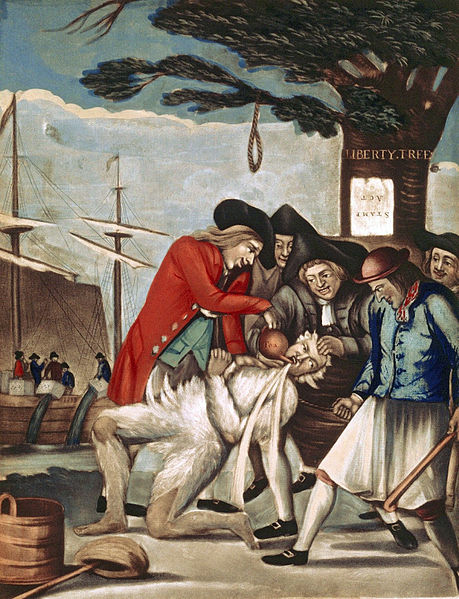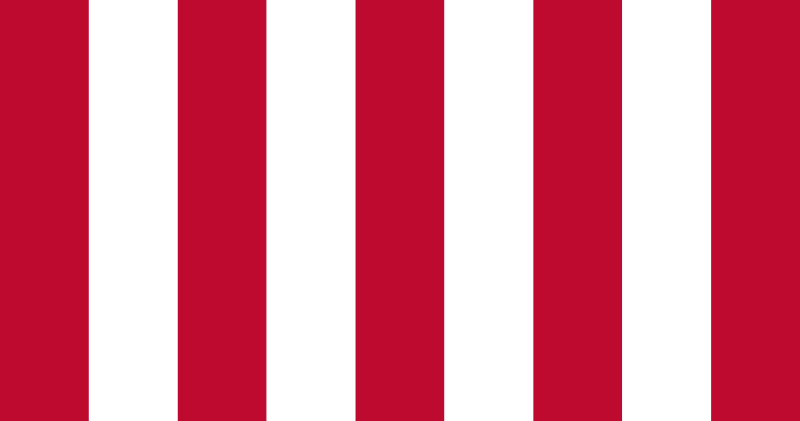The Sons of Liberty was an organization born out of rebellion to the Stamp Act.
Following the French and Indian War, England sought to alleviate war debts by establishing a tax on the colonies. The colonists were angry, asserting that, as they had no representation in Parliament when the Act was passed, it violated their rights as English citizens.
The 1765 Stamp Act inflamed colonial opposition. People began protesting, both with legislative outlets in colonial government, and with public demonstrations.

The Bostonians Paying the Excise-man, or Tarring and Feathering, by Philip Dawes | Public domain image, courtesy of Wikimedia Commons
One such group of protesters was founded in Boston. Made up of shopkeepers, tradesmen, and artisans, they called themselves “the Loyal Nine.” Little is known about them because their illegal operations were carried out in absolute secrecy. The nine men were close friends, therefore the group didn’t operate like an official organization; they left almost no paper trail, though it’s a generally accepted fact that they met at the “Liberty Tree” in Hanover Square where they planned their exploits.
The nearby tavern owners were sympathetic to the Sons of Liberty and their cause, and they met often at the Green Dragon Tavern. The Loyal Nine consisted of club secretary John Avery (a distiller); Henry Bass (a cousin of Samuel Adams); Thomas Chase (also a distiller); Stephen Cleverly and John Smith (both braziers); Thomas Crafts (a painter); Benjamin Edes (printer of the Boston Gazette); Joseph Field (a ship captain); and George Trott (a jeweler).
These nine men banded together to protest the Stamp Act and prevent its taking effect, by violence if necessary. They incited a mob to use fear, force, and intimidation to frighten government officials and pro-Act supporters. They distributed anti-Act literature, hung effigies of public officials, and set the targets the mobs would attack.
In 1765, the Loyal Nine merged with the emerging Sons of Liberty, whose origins are mostly unknown. They burst on the public scene in August 1765 when they hung the effigy of one commissioned Distributor of Stamps for Massachusetts, drawn with a large boot with a devil climbing out of it. (The boot was a play on the name of the Earl of Bute, designed to establish a connection between the Distributor and the Stamp Act.)
They collected a mob in the streets, and the sheriffs were to afraid to take the effigy down. The mob burned Oliver’s property, then moved to his home and beheaded the effigy in front of his home. Then they took it to a nearby hilltop and burned it. Later, under the cover of darkness, they gathered in his home and ransacked it. The British militia nearby supposed to be enforcing the Act did nothing. Oliver resigned shortly afterward.
The name “Sons of Liberty” was given to to the group during a Parliamentary debate. When a Supporter of the Stamp Act criticized the colonists and their reaction to the Act, Isaac fooré, an Irish-born Colonel veteran of the French and Indian War, stood and defended them, calling them “these Sons of Liberty.” He was sympathetic to their views and advocated for them. The name made its way back to the colonies and was adopted.
The Sons’ main objective was to make the stamp distributors in the colonies resign. They did not yet consider independence or separation. some people acted under the name of the sons of liberty to carry out personal vendettas and revenge. members of the sons of liberty worked at newspapers and printed inflammatory articles about the stamp act and glorified the acts of the sons of liberty, obviously, without the required stamp.
Following the incident with Andrew Oliver, the mob attacked Oliver’s brother-in-law, Thomas Hutchison, the Chief Justice and Lieutenant Governor of Massachusetts, and a known Loyalist. The Sons of Liberty demanded Hutchinson denounce the Stamp Act in his letters back to Parliament, but he refused. His home got the same treatment as Oliver’s and he, too, resigned. Meanwhile, the Sons of Liberty designed a flag and formed new chapters all over the colonies.

The Sons adopted a flag called the rebellious stripes flag with nine uneven vertical stripes (five red and four white). It is supposed that nine represented the Loyal Nine. Public domain image
One of the most charismatic leaders of the Sons of Liberty was Samuel Adams, cousin of John Adams. Through his compatriot Benjamin Edes and his Boston Gazette, Samuel Adams wrote a continuous stream of articles, speaking out against the British government, though still claiming loyalty to the King. Like many other colonists, they blamed Parliament for the unfair taxes.<
Over time, the mobs became more violent and less picky about the victims of their crimes. As is the nature of mobs, it became less controlled. Several skirmishes broke out between the British militia and the New York City chapter.
They openly opposed the Tea Act, which gave the East India Company a monopoly on tea import, declaring supporters of the Act to be enemies of liberty. They actively challenged it by sneaking on board a British ship dressed as Native Americans and throwing several tons of tea into the harbor in what became known as the Boston Tea Party.
After the Revolution, the organization was reestablished and its members infiltrated the New York Assembly, gaining enough seats to vote for the confiscation of Loyalist homes and property.
Aside from Samuel Adams, other notable members of the Sons were John Adams, Benedict Arnold, John Hancock, Patrick Henry, Paul Revere, Benjamin Rush, Joseph Warren, and Oliver Wolcott.


